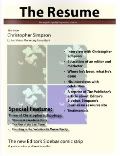When consultants go bad
The following is a reprint of the Ad Nauseam column which appeared in the June 24, 2008 edition of the Metaverse Messenger
Ad Nauseam
By HOLMAN TIBBETT
While this column frequently talks with advertising consultants, I feel it necessary to give a mild word of warning: a great many of them are clinically insane.
Not all, of course. I have no wish to tar every consultant with the same brush. Many of them are merely idiots.
“You’ve got to have a presence in Second Life,” they tell their corporate clients. “Just build a duplicate of your main offices and people will flock to them.”
“What should we call our new line of beds for young girls?” asks a Woolworth’s executive. “How about ‘Lolitia’?” responds his trained consultant.
These are mere errors of judgment, mistakes made everyday by people with no actual knowledge of what they’re talking about.
The clinically insane consultant, however, is an entirely different breed.
It’s not their fault. The very nature of the consulting industry is such that it promotes a style of thinking that is, by necessity, contrary to common sense. After all, these people are charging huge sums of money for their ideas, and if the ideas they put forth sound too reasonable their clients will begin to wonder how important it is to have a consultant in the first place.
Consider an incident that occurred in my home town of Toronto, Ontario.
The subway system in 1994 consisted of two routes. One, the Bloor-Danforth route, ran in an east west direction. On maps it was portrayed as a horizontal line. The other, the Yonge-University route, starts in the north, runs to the south end of the city, then curves back in a U-shape and returns to the north. On maps it was portrayed as a vertical U-shaped line intersecting the horizontal Bloor-Danforth line. North, of course, was at the top. West was on the left. In short, a pretty typical map.
Then, in a response to numerous rider complaints about the service, which was slow, filled with delays, and over-crowded, the Toronto Transit Commission (TTC) hired a consulting firm to do something about its maps —which not a single rider had ever complained about.
The consulting firm, realizing that the maps were perfectly fine the way they were, took a long look at the enormous fees they were charging and became creative.
The result was a series of maps, each significantly different from the other.
If you were on one side of the east-west line, the map showed west to the left and east to the right. If you were on the other side of the east-west line the map showed east to the left and west to the right.
Confusing? That wasn’t the half of it.
In some situations the Bloor-Danforth route remained a straight horizontal line intersected by the vertical U-shaped line of the Yonge-University route. But in other situations the straight, horizontal route was shown as a U-shaped vertical line intersected by a straight horizontal line representing the U-shaped Yonge-University route. In other words, not only did the maps arbitrarily switch long-standing conventions of orientation, they also rejected even a graphical representation of the reality.
The official reason for these changes was to make it easier for people from other countries, although which particular countries were never mentioned. The important thing was that the consultants had fulfilled their mandate: they had justified their exorbitant fees by coming up with a solution that would never have occurred to a non-expert.
Fortunately, before the maps went into system-wide distribution they were first posted at select stations and some of the less sensitive, perhaps even cruel, journalists took it upon themselves to ridicule the enterprise. (Why yes, I was one of them — why do you ask?) The transit commission very quietly removed them after a couple of weeks and the entire affair was never mentioned again.
But really good consultants don’t rely merely on schemes hatched while munching on the caterpillar’s mushroom in Wonderland, they also employ a vocabulary especially designed to be beyond comprehension to anyone outside of fellow consultants. They “streamline visionary methodologies,” “drive revolutionary alignments,” and “recontextualize collegial cohorts.” Any failure to keep the mega-jargon in play risks allowing clients a chance to stop and think, which could seriously interfere with the consultants’ ability to “innovate authentic solutions and unleash process-based business partnerships” — all to the tune of a hundred thousand dollars.
Just look at Danka, a company that “delivers value to clients worldwide by using its expert technical and professional services to implement effective document information solutions.” Their actual activity is providing “enterprise imaging systems and services.”
In English, they install printing and fax machines.
I don’t want to give the impression that every consultant or expert is crazy. Many are quite sane con-artists. Others are merely incompetent.
And a few are valuable resources of information and analysis.
The trick is to pick out which is which. It’s not always easy, but there is one fairly reliable rule of thumb. If you can’t understand what they’re saying, run the other direction.
And that’s a conceptual synergy template you can take to the bank. Read more...





